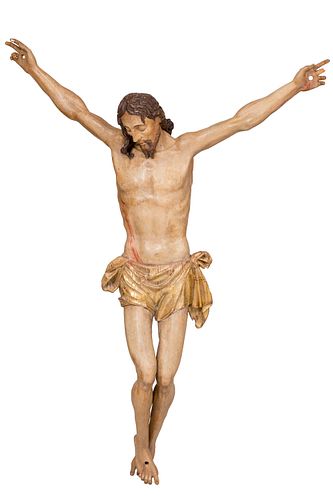Christ; XVI century. Carved wood, polychrome and gilded. It has slight flaws.
Lot 16
About Seller
Setdart Auction House
Carrer Aragó 346
Barcelona
Spain
Setdart Subastas was born in 2004 and is currently the first online art auction in Spain with solidity, prestige and reliability guaranteed by our more than 60,000 users. Setdart has a young, dynamic and enterprising team ready to successfully manage the purchase and sale of art works through custom...Read more
Estimate:
EUR€10,000 - EUR€12,000
$10,752.69 - $12,903.23
Absentee vs Live bid
Two ways to bid:
- Leave a max absentee bid and the platform will bid on your behalf up to your maximum bid during the live auction.
- Bid live during the auction and your bids will be submitted real-time to the auctioneer.
Bid Increments
| Price | Bid Increment |
|---|---|
| EUR€0 | EUR€10 |
| EUR€200 | EUR€25 |
| EUR€500 | EUR€50 |
| EUR€1,000 | EUR€100 |
| EUR€3,000 | EUR€200 |
| EUR€5,000 | EUR€500 |
| EUR€10,000 | EUR€1,000 |
| EUR€20,000 | EUR€2,000 |
| EUR€50,000 | EUR€5,000 |
About Auction
By Setdart Auction House
Oct 20, 2021
Set Reminder
2021-10-20 07:30:00
2021-10-20 07:30:00
America/New_York
Bidsquare
Bidsquare : OLD MASTERS
https://www.bidsquare.com/auctions/setdart-auction-house/old-masters-7700
Setdart Auction House sofia@setdart.com
Setdart Auction House sofia@setdart.com
- Lot Description
Christ; XVI century. Carved wood, polychrome and gilded. It has slight flaws. Measures: 148 x 120 x 34 cm. Round sculpture representing the body of Christ at the moment of the Crucifixion, although it should be noted that in this case it is not anchored to the cross that must have existed in origin. It is a Christ, very stylized anatomically, which is devoid of any anecdotal element such as the crown of thorns. In this case he only wears the usual cloth of purity, which stands out for its subtle folds that reveal the skill of the sculptor. An artist who captures the devotion by executing a serene sculpture, of great detail, where volume and dynamism come together, both in the carving of the details of the face, as in the conception of the whole body. It is the representation of a serene Christ, in spite of having three nails, and not four, which would allow a greater rest of the anatomy, as it is one more point of support. However, despite the presence of these three nails, the image only finds drama through the blood that runs down his side. The rest, especially his face, conveys a sense of peace and calm, especially highlighting the gesture he adopts with his mouth, which seems to smile, thus accepting his fate. Crucifixions and crucifixes have appeared in the history of art and popular culture since before the era of the pagan Roman Empire. The crucifixion of Jesus has been depicted in religious art since the 4th century. It is one of the most recurring themes in Christian art and the one with the most obvious iconography. Although Christ is sometimes depicted clothed, it is usual to represent his naked body, albeit with the genitals covered with a purity cloth (perizonium); full nudes are very rare, but prominent (Brunelleschi, Michelangelo, Cellini). The conventions of representation of the different attitudes of the crucified Christ are designated by the Latin expressions Christus triumphans ("triumphant" -not to be confused with the Maiestas Domini or the Pantocrator-), Christus patiens ("resigned" -not to be confused with the Christ of patience-) and Christus dolens ("suffering" -not to be confused with the Vir dolorum-). The triumphans is represented alive, with open eyes and erect body; the patiens is represented dead, with the will totally emptied (kenosis), the head inclined, the face with serene expression, the eyes closed and the body arched, showing the five wounds; the dolens is represented in a similar way to the patiens, but with a gesture of pain, particularly in the mouth (curved).
- Shipping Info
-
In-house shipping available. Please inquire at admin@setdart.com.
-
- Buyer's Premium



 EUR
EUR CAD
CAD AUD
AUD GBP
GBP MXN
MXN HKD
HKD CNY
CNY MYR
MYR SEK
SEK SGD
SGD CHF
CHF THB
THB









